Logistics and Operations Management Strategies for Tesco's Success
VerifiedAdded on 2020/02/05
|9
|2778
|418
Report
AI Summary
This report provides a comprehensive analysis of Tesco's operations management, focusing on logistics, competitive strategies, and sustainable development. It explores how Tesco can compete within the business area, examining its approach to customer satisfaction, product lines, and distribution channels. The report details the four processes of operations strategy stages and applies them to Tesco, covering strategy formulation, implementation, monitoring, and control. It also discusses different business and competitive strategies Tesco might employ, including those for sustainable development, business expansion, long-term growth, and meeting competitive scenarios. The contribution of operations management to the organization's strategy improvement is highlighted, emphasizing its role in enhancing performance, managing supply and demand, and improving product and service quality. The report concludes with recommendations for improvements in Tesco's logistics and operations, emphasizing the importance of quality, employee control, and operational planning to maintain a competitive edge and drive customer satisfaction.
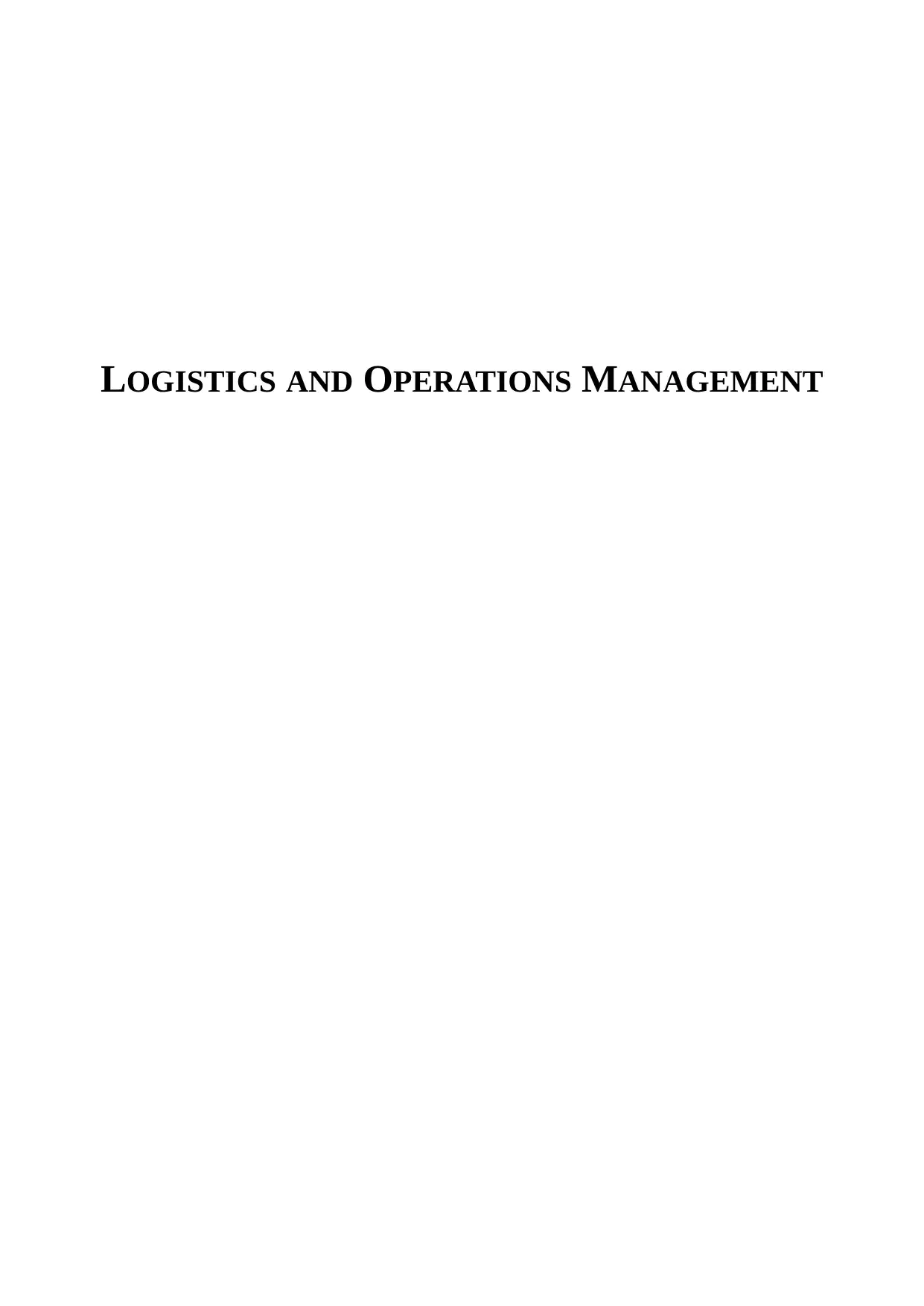
LOGISTICS AND OPERATIONS MANAGEMENT
Paraphrase This Document
Need a fresh take? Get an instant paraphrase of this document with our AI Paraphraser

Table of Contents
Introduction .........................................................................................................................................3
Assignment tasks..................................................................................................................................3
How Tesco can compete within the business area...........................................................................3
Four processes of operations strategy stages and apply it for Tesco ..............................................4
Different business or competitive strategies Tesco might employ by using operations objectives.5
Contribution of operations management to the organization's strategy improvement ...................6
Conclusion ...........................................................................................................................................6
Recommendations................................................................................................................................6
References ...........................................................................................................................................8
Introduction .........................................................................................................................................3
Assignment tasks..................................................................................................................................3
How Tesco can compete within the business area...........................................................................3
Four processes of operations strategy stages and apply it for Tesco ..............................................4
Different business or competitive strategies Tesco might employ by using operations objectives.5
Contribution of operations management to the organization's strategy improvement ...................6
Conclusion ...........................................................................................................................................6
Recommendations................................................................................................................................6
References ...........................................................................................................................................8
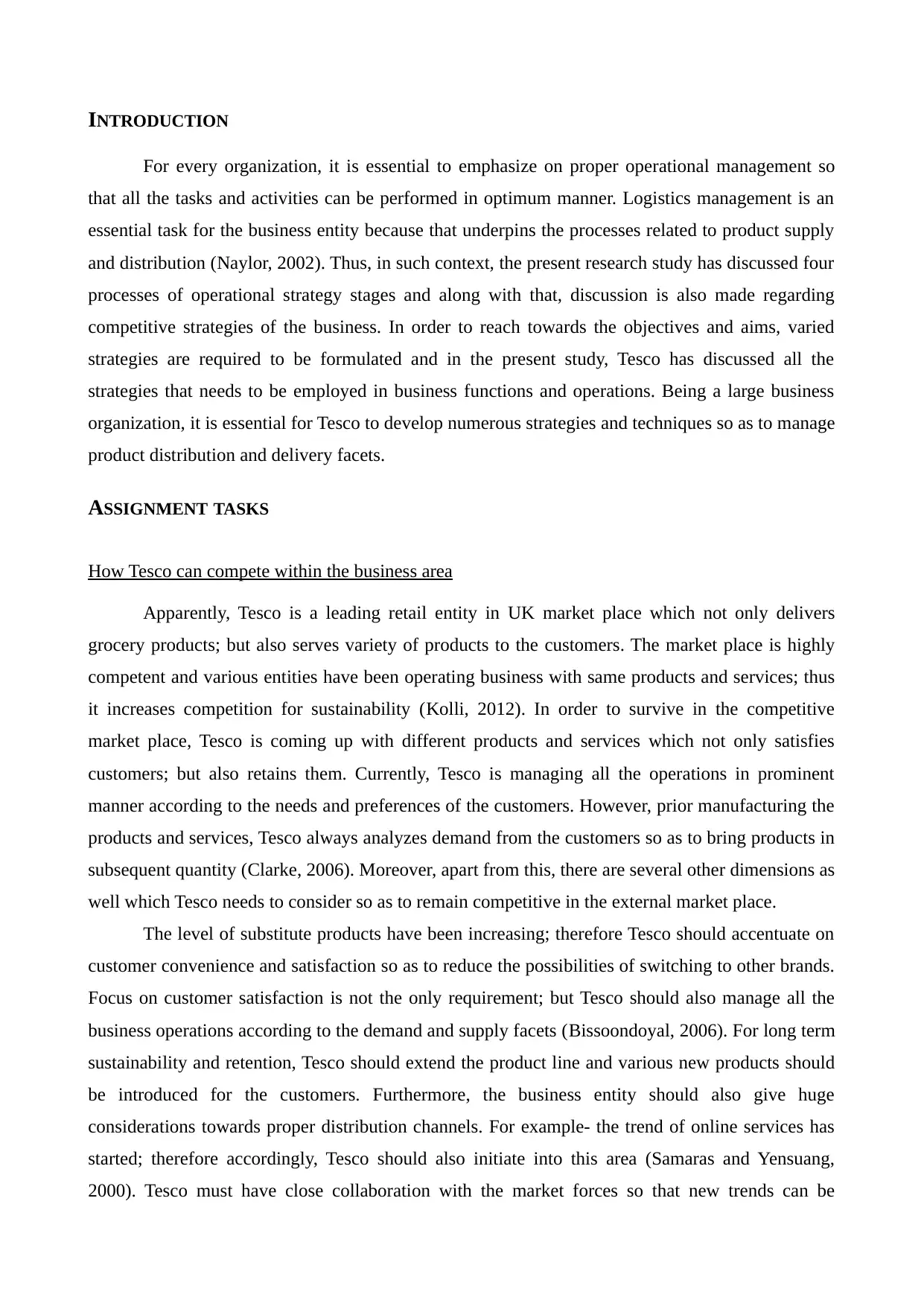
INTRODUCTION
For every organization, it is essential to emphasize on proper operational management so
that all the tasks and activities can be performed in optimum manner. Logistics management is an
essential task for the business entity because that underpins the processes related to product supply
and distribution (Naylor, 2002). Thus, in such context, the present research study has discussed four
processes of operational strategy stages and along with that, discussion is also made regarding
competitive strategies of the business. In order to reach towards the objectives and aims, varied
strategies are required to be formulated and in the present study, Tesco has discussed all the
strategies that needs to be employed in business functions and operations. Being a large business
organization, it is essential for Tesco to develop numerous strategies and techniques so as to manage
product distribution and delivery facets.
ASSIGNMENT TASKS
How Tesco can compete within the business area
Apparently, Tesco is a leading retail entity in UK market place which not only delivers
grocery products; but also serves variety of products to the customers. The market place is highly
competent and various entities have been operating business with same products and services; thus
it increases competition for sustainability (Kolli, 2012). In order to survive in the competitive
market place, Tesco is coming up with different products and services which not only satisfies
customers; but also retains them. Currently, Tesco is managing all the operations in prominent
manner according to the needs and preferences of the customers. However, prior manufacturing the
products and services, Tesco always analyzes demand from the customers so as to bring products in
subsequent quantity (Clarke, 2006). Moreover, apart from this, there are several other dimensions as
well which Tesco needs to consider so as to remain competitive in the external market place.
The level of substitute products have been increasing; therefore Tesco should accentuate on
customer convenience and satisfaction so as to reduce the possibilities of switching to other brands.
Focus on customer satisfaction is not the only requirement; but Tesco should also manage all the
business operations according to the demand and supply facets (Bissoondoyal, 2006). For long term
sustainability and retention, Tesco should extend the product line and various new products should
be introduced for the customers. Furthermore, the business entity should also give huge
considerations towards proper distribution channels. For example- the trend of online services has
started; therefore accordingly, Tesco should also initiate into this area (Samaras and Yensuang,
2000). Tesco must have close collaboration with the market forces so that new trends can be
For every organization, it is essential to emphasize on proper operational management so
that all the tasks and activities can be performed in optimum manner. Logistics management is an
essential task for the business entity because that underpins the processes related to product supply
and distribution (Naylor, 2002). Thus, in such context, the present research study has discussed four
processes of operational strategy stages and along with that, discussion is also made regarding
competitive strategies of the business. In order to reach towards the objectives and aims, varied
strategies are required to be formulated and in the present study, Tesco has discussed all the
strategies that needs to be employed in business functions and operations. Being a large business
organization, it is essential for Tesco to develop numerous strategies and techniques so as to manage
product distribution and delivery facets.
ASSIGNMENT TASKS
How Tesco can compete within the business area
Apparently, Tesco is a leading retail entity in UK market place which not only delivers
grocery products; but also serves variety of products to the customers. The market place is highly
competent and various entities have been operating business with same products and services; thus
it increases competition for sustainability (Kolli, 2012). In order to survive in the competitive
market place, Tesco is coming up with different products and services which not only satisfies
customers; but also retains them. Currently, Tesco is managing all the operations in prominent
manner according to the needs and preferences of the customers. However, prior manufacturing the
products and services, Tesco always analyzes demand from the customers so as to bring products in
subsequent quantity (Clarke, 2006). Moreover, apart from this, there are several other dimensions as
well which Tesco needs to consider so as to remain competitive in the external market place.
The level of substitute products have been increasing; therefore Tesco should accentuate on
customer convenience and satisfaction so as to reduce the possibilities of switching to other brands.
Focus on customer satisfaction is not the only requirement; but Tesco should also manage all the
business operations according to the demand and supply facets (Bissoondoyal, 2006). For long term
sustainability and retention, Tesco should extend the product line and various new products should
be introduced for the customers. Furthermore, the business entity should also give huge
considerations towards proper distribution channels. For example- the trend of online services has
started; therefore accordingly, Tesco should also initiate into this area (Samaras and Yensuang,
2000). Tesco must have close collaboration with the market forces so that new trends can be
⊘ This is a preview!⊘
Do you want full access?
Subscribe today to unlock all pages.

Trusted by 1+ million students worldwide
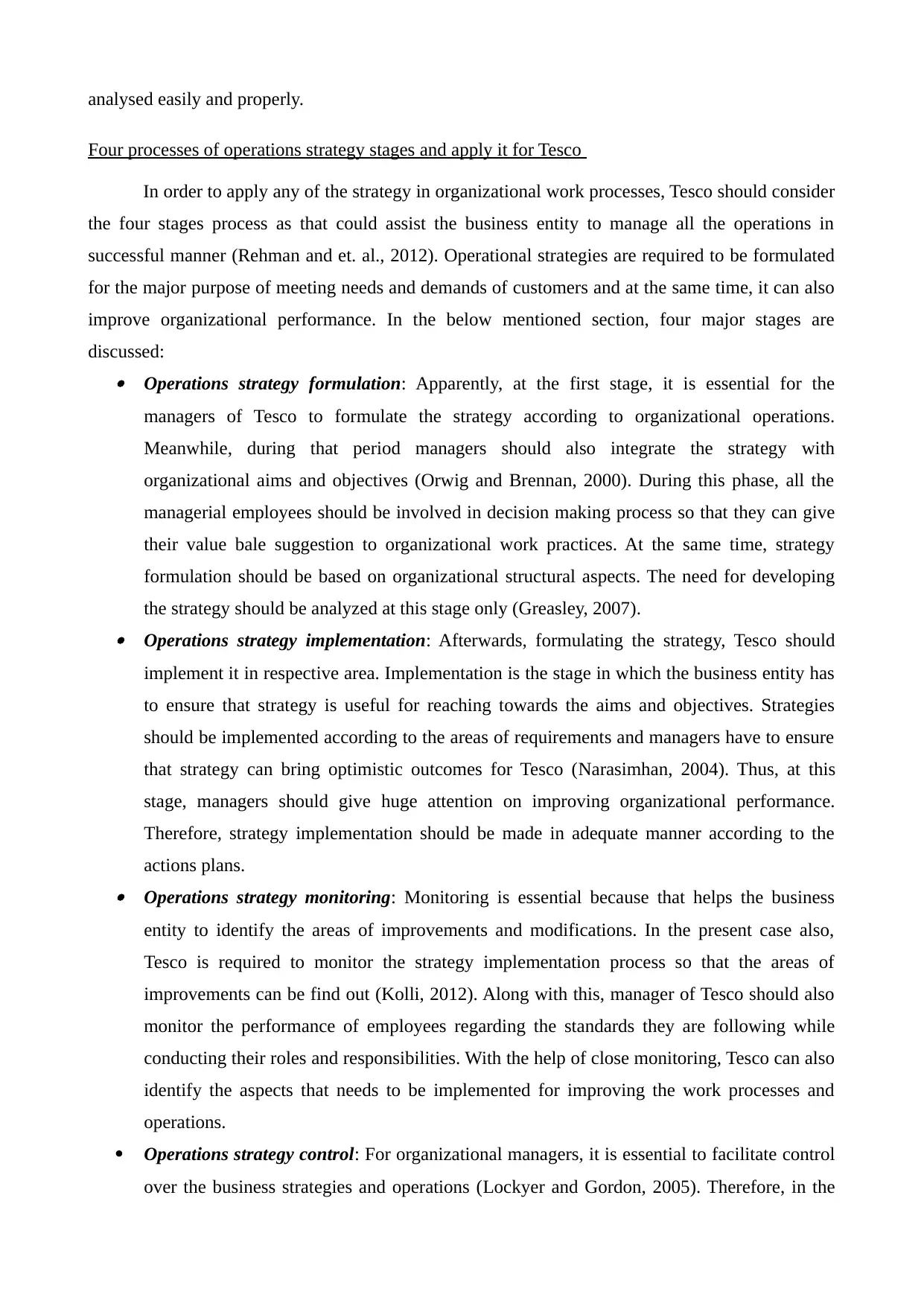
analysed easily and properly.
Four processes of operations strategy stages and apply it for Tesco
In order to apply any of the strategy in organizational work processes, Tesco should consider
the four stages process as that could assist the business entity to manage all the operations in
successful manner (Rehman and et. al., 2012). Operational strategies are required to be formulated
for the major purpose of meeting needs and demands of customers and at the same time, it can also
improve organizational performance. In the below mentioned section, four major stages are
discussed: Operations strategy formulation: Apparently, at the first stage, it is essential for the
managers of Tesco to formulate the strategy according to organizational operations.
Meanwhile, during that period managers should also integrate the strategy with
organizational aims and objectives (Orwig and Brennan, 2000). During this phase, all the
managerial employees should be involved in decision making process so that they can give
their value bale suggestion to organizational work practices. At the same time, strategy
formulation should be based on organizational structural aspects. The need for developing
the strategy should be analyzed at this stage only (Greasley, 2007). Operations strategy implementation: Afterwards, formulating the strategy, Tesco should
implement it in respective area. Implementation is the stage in which the business entity has
to ensure that strategy is useful for reaching towards the aims and objectives. Strategies
should be implemented according to the areas of requirements and managers have to ensure
that strategy can bring optimistic outcomes for Tesco (Narasimhan, 2004). Thus, at this
stage, managers should give huge attention on improving organizational performance.
Therefore, strategy implementation should be made in adequate manner according to the
actions plans. Operations strategy monitoring: Monitoring is essential because that helps the business
entity to identify the areas of improvements and modifications. In the present case also,
Tesco is required to monitor the strategy implementation process so that the areas of
improvements can be find out (Kolli, 2012). Along with this, manager of Tesco should also
monitor the performance of employees regarding the standards they are following while
conducting their roles and responsibilities. With the help of close monitoring, Tesco can also
identify the aspects that needs to be implemented for improving the work processes and
operations.
Operations strategy control: For organizational managers, it is essential to facilitate control
over the business strategies and operations (Lockyer and Gordon, 2005). Therefore, in the
Four processes of operations strategy stages and apply it for Tesco
In order to apply any of the strategy in organizational work processes, Tesco should consider
the four stages process as that could assist the business entity to manage all the operations in
successful manner (Rehman and et. al., 2012). Operational strategies are required to be formulated
for the major purpose of meeting needs and demands of customers and at the same time, it can also
improve organizational performance. In the below mentioned section, four major stages are
discussed: Operations strategy formulation: Apparently, at the first stage, it is essential for the
managers of Tesco to formulate the strategy according to organizational operations.
Meanwhile, during that period managers should also integrate the strategy with
organizational aims and objectives (Orwig and Brennan, 2000). During this phase, all the
managerial employees should be involved in decision making process so that they can give
their value bale suggestion to organizational work practices. At the same time, strategy
formulation should be based on organizational structural aspects. The need for developing
the strategy should be analyzed at this stage only (Greasley, 2007). Operations strategy implementation: Afterwards, formulating the strategy, Tesco should
implement it in respective area. Implementation is the stage in which the business entity has
to ensure that strategy is useful for reaching towards the aims and objectives. Strategies
should be implemented according to the areas of requirements and managers have to ensure
that strategy can bring optimistic outcomes for Tesco (Narasimhan, 2004). Thus, at this
stage, managers should give huge attention on improving organizational performance.
Therefore, strategy implementation should be made in adequate manner according to the
actions plans. Operations strategy monitoring: Monitoring is essential because that helps the business
entity to identify the areas of improvements and modifications. In the present case also,
Tesco is required to monitor the strategy implementation process so that the areas of
improvements can be find out (Kolli, 2012). Along with this, manager of Tesco should also
monitor the performance of employees regarding the standards they are following while
conducting their roles and responsibilities. With the help of close monitoring, Tesco can also
identify the aspects that needs to be implemented for improving the work processes and
operations.
Operations strategy control: For organizational managers, it is essential to facilitate control
over the business strategies and operations (Lockyer and Gordon, 2005). Therefore, in the
Paraphrase This Document
Need a fresh take? Get an instant paraphrase of this document with our AI Paraphraser
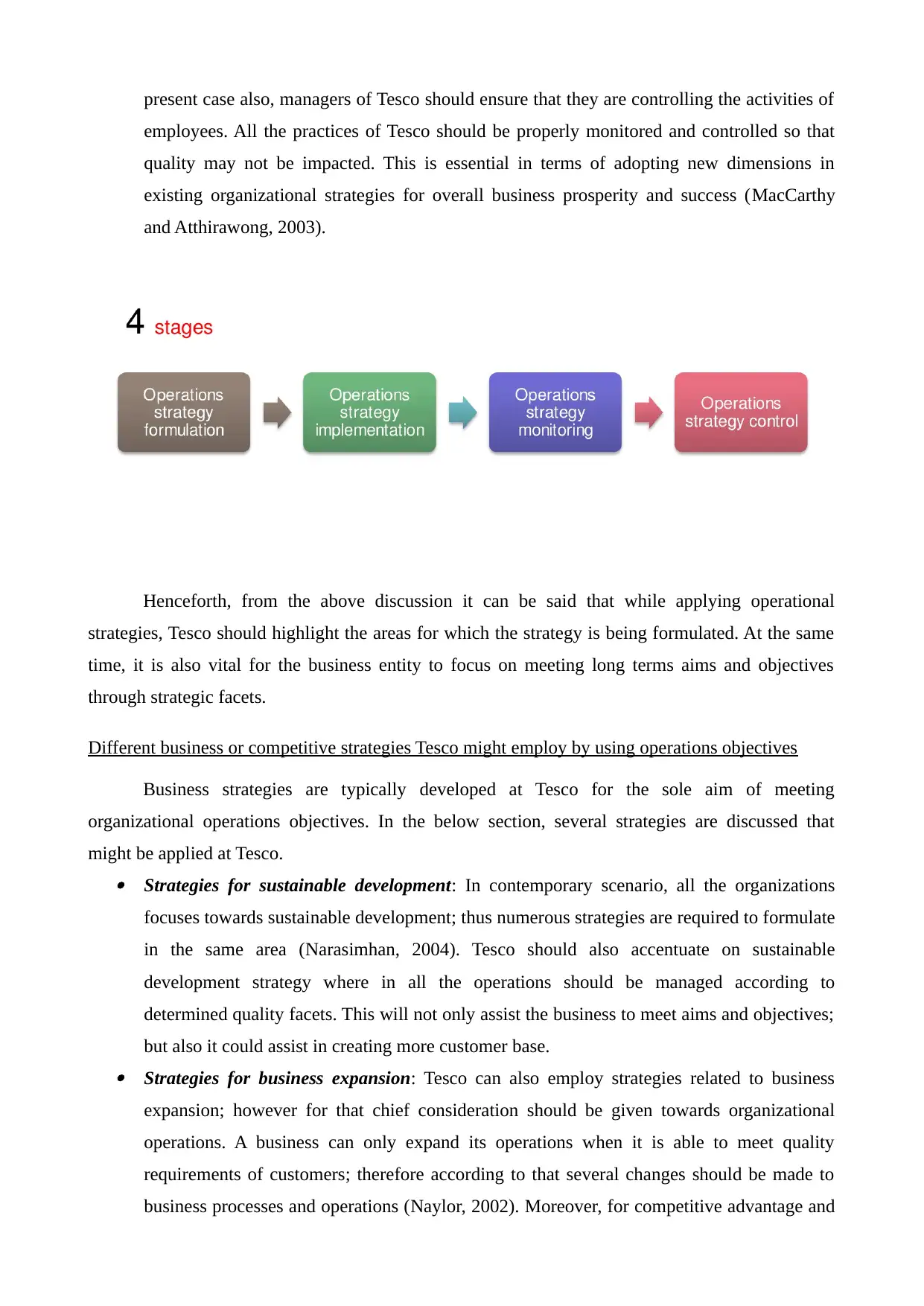
present case also, managers of Tesco should ensure that they are controlling the activities of
employees. All the practices of Tesco should be properly monitored and controlled so that
quality may not be impacted. This is essential in terms of adopting new dimensions in
existing organizational strategies for overall business prosperity and success (MacCarthy
and Atthirawong, 2003).
Henceforth, from the above discussion it can be said that while applying operational
strategies, Tesco should highlight the areas for which the strategy is being formulated. At the same
time, it is also vital for the business entity to focus on meeting long terms aims and objectives
through strategic facets.
Different business or competitive strategies Tesco might employ by using operations objectives
Business strategies are typically developed at Tesco for the sole aim of meeting
organizational operations objectives. In the below section, several strategies are discussed that
might be applied at Tesco. Strategies for sustainable development: In contemporary scenario, all the organizations
focuses towards sustainable development; thus numerous strategies are required to formulate
in the same area (Narasimhan, 2004). Tesco should also accentuate on sustainable
development strategy where in all the operations should be managed according to
determined quality facets. This will not only assist the business to meet aims and objectives;
but also it could assist in creating more customer base. Strategies for business expansion: Tesco can also employ strategies related to business
expansion; however for that chief consideration should be given towards organizational
operations. A business can only expand its operations when it is able to meet quality
requirements of customers; therefore according to that several changes should be made to
business processes and operations (Naylor, 2002). Moreover, for competitive advantage and
employees. All the practices of Tesco should be properly monitored and controlled so that
quality may not be impacted. This is essential in terms of adopting new dimensions in
existing organizational strategies for overall business prosperity and success (MacCarthy
and Atthirawong, 2003).
Henceforth, from the above discussion it can be said that while applying operational
strategies, Tesco should highlight the areas for which the strategy is being formulated. At the same
time, it is also vital for the business entity to focus on meeting long terms aims and objectives
through strategic facets.
Different business or competitive strategies Tesco might employ by using operations objectives
Business strategies are typically developed at Tesco for the sole aim of meeting
organizational operations objectives. In the below section, several strategies are discussed that
might be applied at Tesco. Strategies for sustainable development: In contemporary scenario, all the organizations
focuses towards sustainable development; thus numerous strategies are required to formulate
in the same area (Narasimhan, 2004). Tesco should also accentuate on sustainable
development strategy where in all the operations should be managed according to
determined quality facets. This will not only assist the business to meet aims and objectives;
but also it could assist in creating more customer base. Strategies for business expansion: Tesco can also employ strategies related to business
expansion; however for that chief consideration should be given towards organizational
operations. A business can only expand its operations when it is able to meet quality
requirements of customers; therefore according to that several changes should be made to
business processes and operations (Naylor, 2002). Moreover, for competitive advantage and
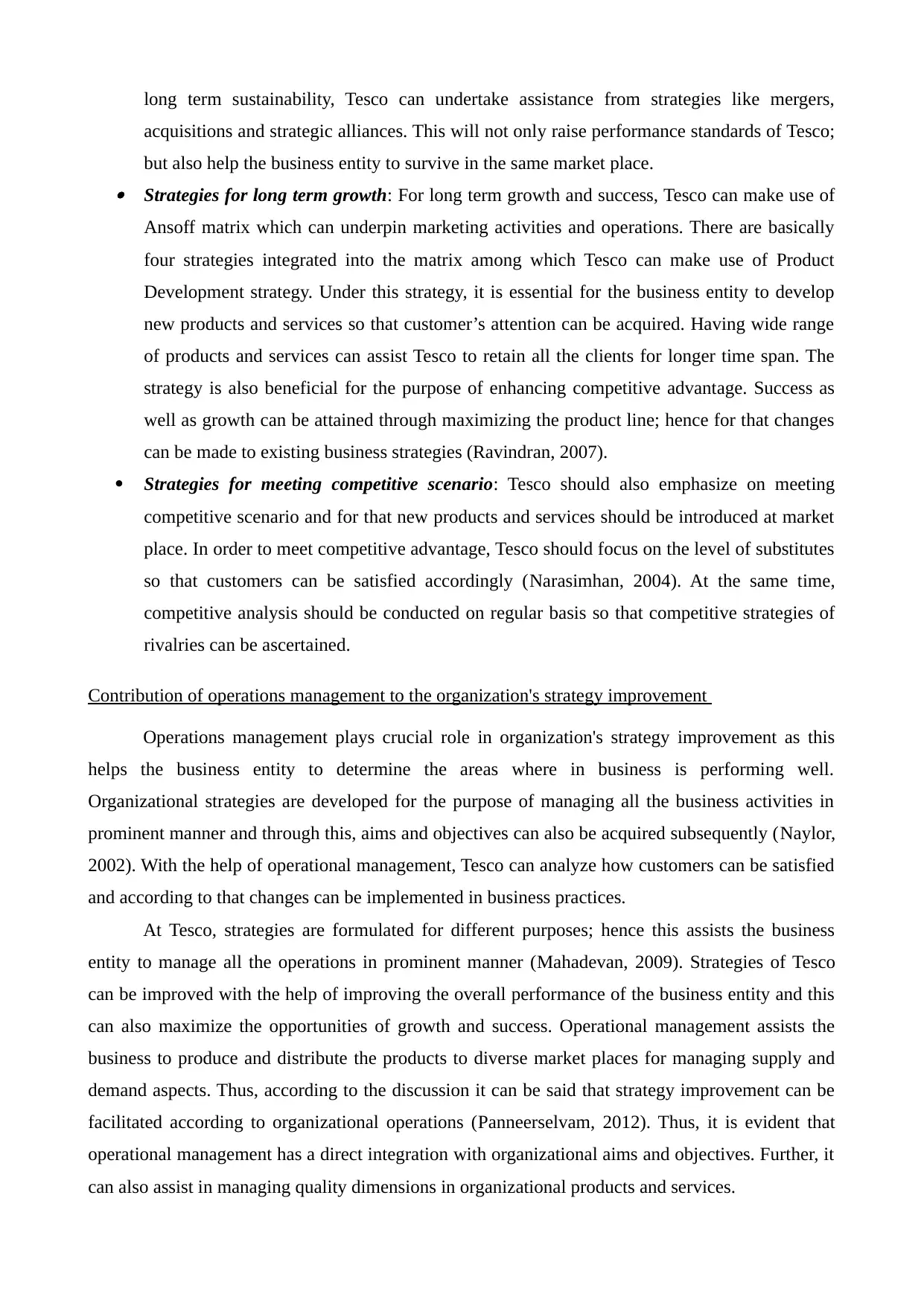
long term sustainability, Tesco can undertake assistance from strategies like mergers,
acquisitions and strategic alliances. This will not only raise performance standards of Tesco;
but also help the business entity to survive in the same market place. Strategies for long term growth: For long term growth and success, Tesco can make use of
Ansoff matrix which can underpin marketing activities and operations. There are basically
four strategies integrated into the matrix among which Tesco can make use of Product
Development strategy. Under this strategy, it is essential for the business entity to develop
new products and services so that customer’s attention can be acquired. Having wide range
of products and services can assist Tesco to retain all the clients for longer time span. The
strategy is also beneficial for the purpose of enhancing competitive advantage. Success as
well as growth can be attained through maximizing the product line; hence for that changes
can be made to existing business strategies (Ravindran, 2007).
Strategies for meeting competitive scenario: Tesco should also emphasize on meeting
competitive scenario and for that new products and services should be introduced at market
place. In order to meet competitive advantage, Tesco should focus on the level of substitutes
so that customers can be satisfied accordingly (Narasimhan, 2004). At the same time,
competitive analysis should be conducted on regular basis so that competitive strategies of
rivalries can be ascertained.
Contribution of operations management to the organization's strategy improvement
Operations management plays crucial role in organization's strategy improvement as this
helps the business entity to determine the areas where in business is performing well.
Organizational strategies are developed for the purpose of managing all the business activities in
prominent manner and through this, aims and objectives can also be acquired subsequently (Naylor,
2002). With the help of operational management, Tesco can analyze how customers can be satisfied
and according to that changes can be implemented in business practices.
At Tesco, strategies are formulated for different purposes; hence this assists the business
entity to manage all the operations in prominent manner (Mahadevan, 2009). Strategies of Tesco
can be improved with the help of improving the overall performance of the business entity and this
can also maximize the opportunities of growth and success. Operational management assists the
business to produce and distribute the products to diverse market places for managing supply and
demand aspects. Thus, according to the discussion it can be said that strategy improvement can be
facilitated according to organizational operations (Panneerselvam, 2012). Thus, it is evident that
operational management has a direct integration with organizational aims and objectives. Further, it
can also assist in managing quality dimensions in organizational products and services.
acquisitions and strategic alliances. This will not only raise performance standards of Tesco;
but also help the business entity to survive in the same market place. Strategies for long term growth: For long term growth and success, Tesco can make use of
Ansoff matrix which can underpin marketing activities and operations. There are basically
four strategies integrated into the matrix among which Tesco can make use of Product
Development strategy. Under this strategy, it is essential for the business entity to develop
new products and services so that customer’s attention can be acquired. Having wide range
of products and services can assist Tesco to retain all the clients for longer time span. The
strategy is also beneficial for the purpose of enhancing competitive advantage. Success as
well as growth can be attained through maximizing the product line; hence for that changes
can be made to existing business strategies (Ravindran, 2007).
Strategies for meeting competitive scenario: Tesco should also emphasize on meeting
competitive scenario and for that new products and services should be introduced at market
place. In order to meet competitive advantage, Tesco should focus on the level of substitutes
so that customers can be satisfied accordingly (Narasimhan, 2004). At the same time,
competitive analysis should be conducted on regular basis so that competitive strategies of
rivalries can be ascertained.
Contribution of operations management to the organization's strategy improvement
Operations management plays crucial role in organization's strategy improvement as this
helps the business entity to determine the areas where in business is performing well.
Organizational strategies are developed for the purpose of managing all the business activities in
prominent manner and through this, aims and objectives can also be acquired subsequently (Naylor,
2002). With the help of operational management, Tesco can analyze how customers can be satisfied
and according to that changes can be implemented in business practices.
At Tesco, strategies are formulated for different purposes; hence this assists the business
entity to manage all the operations in prominent manner (Mahadevan, 2009). Strategies of Tesco
can be improved with the help of improving the overall performance of the business entity and this
can also maximize the opportunities of growth and success. Operational management assists the
business to produce and distribute the products to diverse market places for managing supply and
demand aspects. Thus, according to the discussion it can be said that strategy improvement can be
facilitated according to organizational operations (Panneerselvam, 2012). Thus, it is evident that
operational management has a direct integration with organizational aims and objectives. Further, it
can also assist in managing quality dimensions in organizational products and services.
⊘ This is a preview!⊘
Do you want full access?
Subscribe today to unlock all pages.

Trusted by 1+ million students worldwide
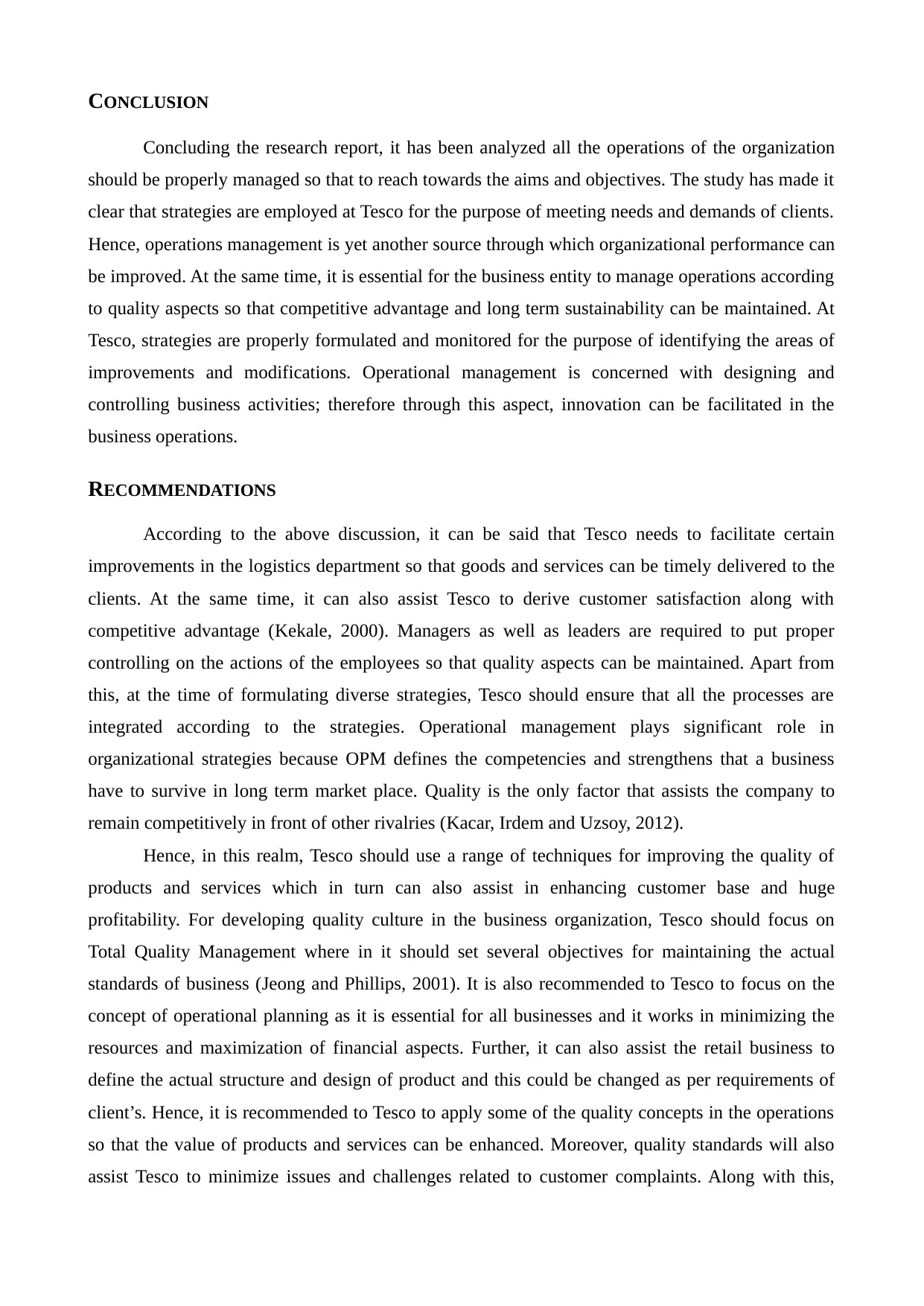
CONCLUSION
Concluding the research report, it has been analyzed all the operations of the organization
should be properly managed so that to reach towards the aims and objectives. The study has made it
clear that strategies are employed at Tesco for the purpose of meeting needs and demands of clients.
Hence, operations management is yet another source through which organizational performance can
be improved. At the same time, it is essential for the business entity to manage operations according
to quality aspects so that competitive advantage and long term sustainability can be maintained. At
Tesco, strategies are properly formulated and monitored for the purpose of identifying the areas of
improvements and modifications. Operational management is concerned with designing and
controlling business activities; therefore through this aspect, innovation can be facilitated in the
business operations.
RECOMMENDATIONS
According to the above discussion, it can be said that Tesco needs to facilitate certain
improvements in the logistics department so that goods and services can be timely delivered to the
clients. At the same time, it can also assist Tesco to derive customer satisfaction along with
competitive advantage (Kekale, 2000). Managers as well as leaders are required to put proper
controlling on the actions of the employees so that quality aspects can be maintained. Apart from
this, at the time of formulating diverse strategies, Tesco should ensure that all the processes are
integrated according to the strategies. Operational management plays significant role in
organizational strategies because OPM defines the competencies and strengthens that a business
have to survive in long term market place. Quality is the only factor that assists the company to
remain competitively in front of other rivalries (Kacar, Irdem and Uzsoy, 2012).
Hence, in this realm, Tesco should use a range of techniques for improving the quality of
products and services which in turn can also assist in enhancing customer base and huge
profitability. For developing quality culture in the business organization, Tesco should focus on
Total Quality Management where in it should set several objectives for maintaining the actual
standards of business (Jeong and Phillips, 2001). It is also recommended to Tesco to focus on the
concept of operational planning as it is essential for all businesses and it works in minimizing the
resources and maximization of financial aspects. Further, it can also assist the retail business to
define the actual structure and design of product and this could be changed as per requirements of
client’s. Hence, it is recommended to Tesco to apply some of the quality concepts in the operations
so that the value of products and services can be enhanced. Moreover, quality standards will also
assist Tesco to minimize issues and challenges related to customer complaints. Along with this,
Concluding the research report, it has been analyzed all the operations of the organization
should be properly managed so that to reach towards the aims and objectives. The study has made it
clear that strategies are employed at Tesco for the purpose of meeting needs and demands of clients.
Hence, operations management is yet another source through which organizational performance can
be improved. At the same time, it is essential for the business entity to manage operations according
to quality aspects so that competitive advantage and long term sustainability can be maintained. At
Tesco, strategies are properly formulated and monitored for the purpose of identifying the areas of
improvements and modifications. Operational management is concerned with designing and
controlling business activities; therefore through this aspect, innovation can be facilitated in the
business operations.
RECOMMENDATIONS
According to the above discussion, it can be said that Tesco needs to facilitate certain
improvements in the logistics department so that goods and services can be timely delivered to the
clients. At the same time, it can also assist Tesco to derive customer satisfaction along with
competitive advantage (Kekale, 2000). Managers as well as leaders are required to put proper
controlling on the actions of the employees so that quality aspects can be maintained. Apart from
this, at the time of formulating diverse strategies, Tesco should ensure that all the processes are
integrated according to the strategies. Operational management plays significant role in
organizational strategies because OPM defines the competencies and strengthens that a business
have to survive in long term market place. Quality is the only factor that assists the company to
remain competitively in front of other rivalries (Kacar, Irdem and Uzsoy, 2012).
Hence, in this realm, Tesco should use a range of techniques for improving the quality of
products and services which in turn can also assist in enhancing customer base and huge
profitability. For developing quality culture in the business organization, Tesco should focus on
Total Quality Management where in it should set several objectives for maintaining the actual
standards of business (Jeong and Phillips, 2001). It is also recommended to Tesco to focus on the
concept of operational planning as it is essential for all businesses and it works in minimizing the
resources and maximization of financial aspects. Further, it can also assist the retail business to
define the actual structure and design of product and this could be changed as per requirements of
client’s. Hence, it is recommended to Tesco to apply some of the quality concepts in the operations
so that the value of products and services can be enhanced. Moreover, quality standards will also
assist Tesco to minimize issues and challenges related to customer complaints. Along with this,
Paraphrase This Document
Need a fresh take? Get an instant paraphrase of this document with our AI Paraphraser

managers should emphasize on strategy formulation process so that resource constraints may not
impede organizational operations.
impede organizational operations.
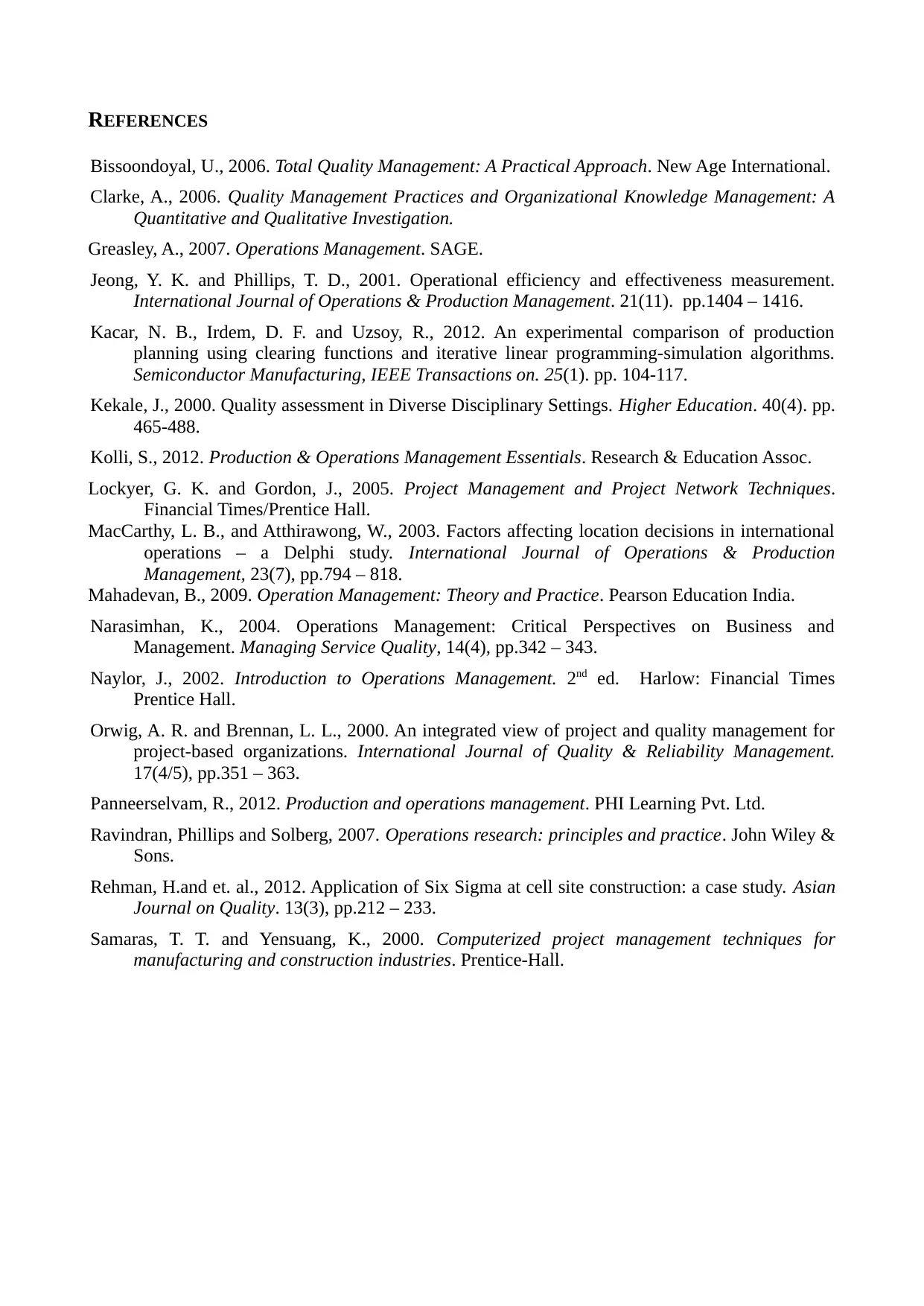
REFERENCES
Bissoondoyal, U., 2006. Total Quality Management: A Practical Approach. New Age International.
Clarke, A., 2006. Quality Management Practices and Organizational Knowledge Management: A
Quantitative and Qualitative Investigation.
Greasley, A., 2007. Operations Management. SAGE.
Jeong, Y. K. and Phillips, T. D., 2001. Operational efficiency and effectiveness measurement.
International Journal of Operations & Production Management. 21(11). pp.1404 – 1416.
Kacar, N. B., Irdem, D. F. and Uzsoy, R., 2012. An experimental comparison of production
planning using clearing functions and iterative linear programming-simulation algorithms.
Semiconductor Manufacturing, IEEE Transactions on. 25(1). pp. 104-117.
Kekale, J., 2000. Quality assessment in Diverse Disciplinary Settings. Higher Education. 40(4). pp.
465-488.
Kolli, S., 2012. Production & Operations Management Essentials. Research & Education Assoc.
Lockyer, G. K. and Gordon, J., 2005. Project Management and Project Network Techniques.
Financial Times/Prentice Hall.
MacCarthy, L. B., and Atthirawong, W., 2003. Factors affecting location decisions in international
operations – a Delphi study. International Journal of Operations & Production
Management, 23(7), pp.794 – 818.
Mahadevan, B., 2009. Operation Management: Theory and Practice. Pearson Education India.
Narasimhan, K., 2004. Operations Management: Critical Perspectives on Business and
Management. Managing Service Quality, 14(4), pp.342 – 343.
Naylor, J., 2002. Introduction to Operations Management. 2nd ed. Harlow: Financial Times
Prentice Hall.
Orwig, A. R. and Brennan, L. L., 2000. An integrated view of project and quality management for
project-based organizations. International Journal of Quality & Reliability Management.
17(4/5), pp.351 – 363.
Panneerselvam, R., 2012. Production and operations management. PHI Learning Pvt. Ltd.
Ravindran, Phillips and Solberg, 2007. Operations research: principles and practice. John Wiley &
Sons.
Rehman, H.and et. al., 2012. Application of Six Sigma at cell site construction: a case study. Asian
Journal on Quality. 13(3), pp.212 – 233.
Samaras, T. T. and Yensuang, K., 2000. Computerized project management techniques for
manufacturing and construction industries. Prentice-Hall.
Bissoondoyal, U., 2006. Total Quality Management: A Practical Approach. New Age International.
Clarke, A., 2006. Quality Management Practices and Organizational Knowledge Management: A
Quantitative and Qualitative Investigation.
Greasley, A., 2007. Operations Management. SAGE.
Jeong, Y. K. and Phillips, T. D., 2001. Operational efficiency and effectiveness measurement.
International Journal of Operations & Production Management. 21(11). pp.1404 – 1416.
Kacar, N. B., Irdem, D. F. and Uzsoy, R., 2012. An experimental comparison of production
planning using clearing functions and iterative linear programming-simulation algorithms.
Semiconductor Manufacturing, IEEE Transactions on. 25(1). pp. 104-117.
Kekale, J., 2000. Quality assessment in Diverse Disciplinary Settings. Higher Education. 40(4). pp.
465-488.
Kolli, S., 2012. Production & Operations Management Essentials. Research & Education Assoc.
Lockyer, G. K. and Gordon, J., 2005. Project Management and Project Network Techniques.
Financial Times/Prentice Hall.
MacCarthy, L. B., and Atthirawong, W., 2003. Factors affecting location decisions in international
operations – a Delphi study. International Journal of Operations & Production
Management, 23(7), pp.794 – 818.
Mahadevan, B., 2009. Operation Management: Theory and Practice. Pearson Education India.
Narasimhan, K., 2004. Operations Management: Critical Perspectives on Business and
Management. Managing Service Quality, 14(4), pp.342 – 343.
Naylor, J., 2002. Introduction to Operations Management. 2nd ed. Harlow: Financial Times
Prentice Hall.
Orwig, A. R. and Brennan, L. L., 2000. An integrated view of project and quality management for
project-based organizations. International Journal of Quality & Reliability Management.
17(4/5), pp.351 – 363.
Panneerselvam, R., 2012. Production and operations management. PHI Learning Pvt. Ltd.
Ravindran, Phillips and Solberg, 2007. Operations research: principles and practice. John Wiley &
Sons.
Rehman, H.and et. al., 2012. Application of Six Sigma at cell site construction: a case study. Asian
Journal on Quality. 13(3), pp.212 – 233.
Samaras, T. T. and Yensuang, K., 2000. Computerized project management techniques for
manufacturing and construction industries. Prentice-Hall.
⊘ This is a preview!⊘
Do you want full access?
Subscribe today to unlock all pages.

Trusted by 1+ million students worldwide
1 out of 9
Related Documents
Your All-in-One AI-Powered Toolkit for Academic Success.
+13062052269
info@desklib.com
Available 24*7 on WhatsApp / Email
![[object Object]](/_next/static/media/star-bottom.7253800d.svg)
Unlock your academic potential
Copyright © 2020–2025 A2Z Services. All Rights Reserved. Developed and managed by ZUCOL.




